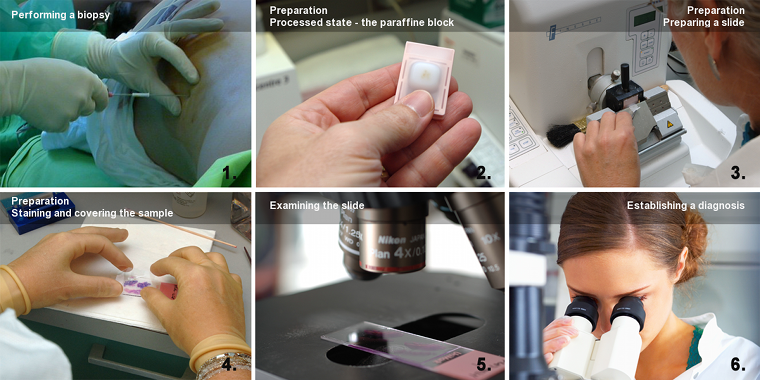 Most of us have no idea what pathologists actually do. Many of us immediately think of a doctor performing autopsies and we shudder. However, we may be connected with pathologists directly or indirectly in many ways: the precise diagnosis of a great deal of diseases are made based on the work of pathologists, and in these cases their function is essential to the successful work of doctors in hospitals. These days there are many pathologists who perform the biopsy of a specific pathognomic alteration themselves, then diagnose the disease by a microscopic examination.
Most of us have no idea what pathologists actually do. Many of us immediately think of a doctor performing autopsies and we shudder. However, we may be connected with pathologists directly or indirectly in many ways: the precise diagnosis of a great deal of diseases are made based on the work of pathologists, and in these cases their function is essential to the successful work of doctors in hospitals. These days there are many pathologists who perform the biopsy of a specific pathognomic alteration themselves, then diagnose the disease by a microscopic examination.
The pathologist determines the type and graveness of the disease based on clinical information (patient examination and imaging data) and the microscopic examination of slides made from biopsy samples. In some cases the pathologist identifies the pathogenic bacteria or fungi, and in the case of tumorous diseases determines their exact stage. Pathological findings often mean the first and foremost step towards recovery. Besides making diagnoses, pathologists support the hospital team (oncologists, surgeons, internists) by their expertise. Many pathologists participate in various research activities and cancer research projects.
One of their tasks is to perform autopsies, to help clarify the processes leading to death as well as to identify the direct cause of death.
The specialist uses a thin or thicker needle to take biopsy samples from the organ or tissue in the body, or the one removed by intervention, which are then prepared through a special process by the assistants for microscopic examination. The sample is placed onto a glass slide, then it is stained in order to make it suitable for microscopic, digital or on-screen examination. By establishing the pathognomic alterations of the tissue, the pathologist is able to give an accurate description and diagnosis of the disease. This is how the pathologist determines whether the patient has a tumorous disease and if so, in which stage. Cytology, an integral part of pathology, forms the basis of gynecological screening as well.

tissue: the totality of cells, functioning aligned, and located next to one another in a specific area
slide: a 4-5 um layer of tissue, placed onto a glass slide
smear: cells, previously removed or sucked from the alteration in question, smeared on a glass slide (object slide)
By establishing accurate diagnoses of diseases, and by counselling on treatments and interventions assisting recovery, pathologists are essential and equal members of the team of doctors responsible for treatment. As the foremost experts on diseases and their effects, pathologists can help tremendously in accurately describing and understanding our illness.
Molecular pathology
Molecular pathology today is the basis for the tailored therapy of several common cancers, including lung, breast, stomach and certain hematological malignancies: the target molecule in the tumor must be identified before personalized therapy can be administered. More details on Wikipedia >>
Virtual microscope
The development of digital microscopy opened the way for online tele-consultation, more accurate microscopical measurements and evaluation, meeting the 21st centrury’s requirements. More details on Wikipedia >>
During the screening for diseases
During the examination of diseases
During the treatment of diseases
In Hungary, pathology departments have become exceptionally undermanned for the past decades, to the extent that it seriously limits their efficiency and, as a consequence, the standard of patient care (e.g. lengthy examination processes, pathology departments remaining without pathology specialists). The number of young phycisians specializing in pathology is extremely low, and there are a great number of retired pathologists still practicing. In addition, young Hungarian pathologists tend to seek employment abroad.
Among the reasons are the profession being unjustifiably underrated and underfinanced (law wages, dated and old-fashioned equipment). It is undeniable that by the underdevelopment of the pathology departments, the quality and standard of patient care correspondingly lags behind the level rightly expected today.
Photos: Wikimedia Commons